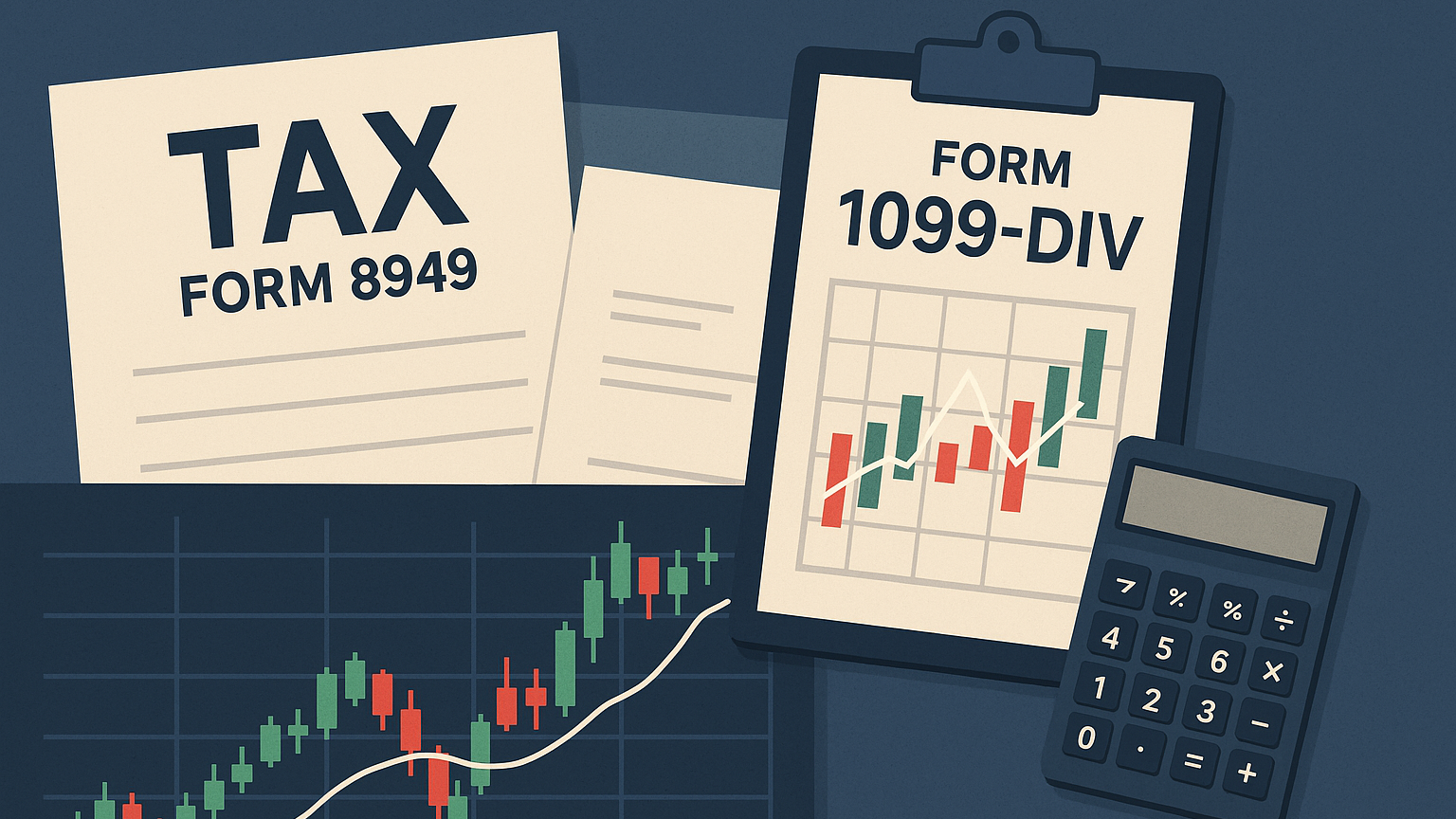Navigate tax season with ease by mastering essential forms for reporting investment income, capital gains, and dividends.
Tax season can be overwhelming for investors, but knowing the right forms simplifies the process. Here's a quick guide to the most important tax documents you'll need to file your investment income accurately:
- Form 1099-DIV: Reports dividend income and capital gain distributions.
- Form 8949: Details your capital asset transactions, like stock or crypto sales.
- Schedule D: Summarizes capital gains and losses, working alongside Form 8949.
- Form 1099-B: Tracks investment sales through brokers, including proceeds and cost basis.
Key tips:
- Organize your documents year-round to avoid errors.
- Differentiate short-term vs. long-term gains - they're taxed differently.
- If you have foreign investments, you may need Form 1116 for a foreign tax credit.
Use this guide to stay compliant, reduce errors, and make tax season stress-free.
Reporting Capital Gains on IRS Form 8949 and Schedule D

Basic Investment Tax Forms
Investment tax forms are essential for accurately reporting your income. Various Form 1099s track different financial activities. Here's a closer look at the main types, their timelines, and how they fit into your tax reporting.
Types of Form 1099
The IRS offers 21 versions of Form 1099, but investors usually encounter these four:
| Form Type | Purpose | When It's Issued |
|---|---|---|
| 1099-DIV | Tracks dividends and capital gains | If you earned dividends from stocks or mutual funds |
| 1099-B | Records proceeds from investment sales | When you sell stocks, commodities, securities, or futures contracts |
| 1099-INT | Reports interest income | For interest payments from banks or other financial institutions |
| 1099-OID | Details original issue discount income | If you hold discounted bonds or notes |
Tax Form Delivery Timeline
Financial institutions follow strict deadlines to ensure you receive tax forms on time. Most investment-related forms are available by mid-February. Here are some key details:
- Online Access: Many brokers offer digital access to forms before mailing physical copies.
- Minimum Earnings: If your account earned less than $10, you might not receive a form.
- Corrections: Firms may send amended forms if errors occur, which could require you to update your filing.
Comparing Investment Tax Forms
Each form focuses on a specific type of income, as shown in the table above. To simplify tax reporting, some brokers combine all relevant information into a single composite statement. This consolidated format makes it easier to ensure all income sources are accounted for during tax preparation.
Form 1099-DIV for Dividend Income
What Form 1099-DIV Shows
Form 1099-DIV provides a summary of dividend income and capital gain distributions from your investments during the tax year. It also outlines how these amounts are taxed.
| Income Type | Tax Treatment | Reporting Location |
|---|---|---|
| Ordinary Dividends (Box 1a) | Taxed at regular income rates (10–37%) | Form 1040, line 3b |
| Qualified Dividends (Box 1b) | Taxed at lower long-term capital gains rates (0%, 15%, or 20%) | Form 1040, line 3a |
| Capital Gain Distributions (Box 2a) | Taxed at long-term capital gains rates | Schedule D |
| Foreign Tax Paid (Box 7) | May qualify for a foreign tax credit | Form 1116 |
Reading Form 1099-DIV
Each box on Form 1099-DIV has specific information you need to report correctly:
- Box 1a – Total Ordinary Dividends: Displays the total taxable dividends. If your dividends exceed $1,500, you’ll need to file Schedule B.
- Box 1b – Qualified Dividends: These dividends are taxed at lower rates. For example, if you’re in the 32% tax bracket, $10,000 of ordinary dividends would result in $3,200 in tax, whereas qualified dividends would only cost $1,500 in tax.
- Box 3 – Nondividend Distributions: These payments reduce your cost basis and aren’t taxable right away.
- Box 4 – Federal Income Tax Withheld: Indicates any tax withheld from your dividend payments.
Filing Dividend Income
- Report all dividend income, even if you didn’t receive a Form 1099-DIV.
- Tax rates for qualified dividends:
- 0% for taxable income below $41,675 (single) or $83,350 (married).
- 15% for incomes between these thresholds.
- 20% for amounts over $459,750 (single) or $517,200 (married).
- If your modified adjusted gross income exceeds $200,000 (single) or $250,000 (married filing jointly), you’ll also owe a 3.8% Net Investment Income Tax.
- Payments from credit unions, even if labeled as dividends, are treated as interest income.
Reporting Gains and Losses
After handling dividend reporting, investors also need to account for gains and losses from sales to finalize their tax filings.
Form 1099-B Overview
Form 1099-B is your go-to document for tracking stock and security sales. It includes critical details like the proceeds from sales and the cost basis, which the IRS uses to confirm your gains or losses.
| Information Type | Description | Location on Form |
|---|---|---|
| Sales Proceeds | Total amount received from selling investments | Box 1d |
| Cost Basis | Original purchase price plus adjustments | Box 1e |
| Holding Period | Indicates if the asset was held short-term or long-term | Box 2 |
| Federal Tax Withheld | Amount withheld for federal taxes | Box 4 |
Steps for Filing Schedule D
-
Organize Transactions
Divide your transactions into two categories: short-term (held for 1 year or less) and long-term (held for more than 1 year). This classification is crucial since short-term gains are taxed at your regular income rate, while long-term gains may qualify for lower tax rates. -
Transfer Totals
Use Form 8949 to summarize your transactions, then transfer the totals to the appropriate parts of Schedule D:- Part I: Short-term capital gains and losses
- Part II: Long-term capital gains and losses
-
Calculate Net Gains or Losses
You can deduct up to $3,000 from other income ($1,500 if married filing separately). Any leftover losses can be carried forward to future tax years.
For a detailed breakdown of transactions, complete Form 8949.
Form 8949: Recording Transactions
Form 8949 requires you to document each investment transaction. It’s divided into two main sections:
| Transaction Type | Form Section | Tax Impact |
|---|---|---|
| Short-term (≤ 1 year) | Part I (Boxes A–C) | Taxed at ordinary income rates |
| Long-term (> 1 year) | Part II (Boxes D–F) | Taxed at long-term capital gains rates |
When filling out Form 8949, include the following details:
- A description of the property sold
- Purchase and sale dates
- Sales price (from Form 1099-B, Box 1d)
- Cost basis (from Form 1099-B, Box 1e)
- Any adjustments needed to match your broker's statements
Accurately reporting all stock sales helps you avoid IRS penalties.
Note: If your Form 1099-B confirms that the cost basis was already reported to the IRS and no adjustments are required, you might be able to skip Form 8949 and report totals directly on Schedule D. Consult a tax professional to ensure you're following the correct process.
Tax Forms for Advanced Investments
As your investment portfolio becomes more complex, you'll encounter additional tax forms beyond the basics like 1099-DIV and Schedule D. Here's what you need to know about key forms for advanced investments.
Form 1099-INT: Reporting Interest Income
Form 1099-INT is used to report interest earned from sources such as savings accounts and CDs. If you earn $10 or more in interest during the tax year, your financial institution is required to send you this form. It breaks down your interest income into specific categories:
| Box Number | Type of Interest | What to Report |
|---|---|---|
| Box 1 | Taxable Interest | Interest from savings accounts, CDs |
| Box 3 | U.S. Treasury Interest | Interest from government securities |
| Box 8 | Tax-Exempt Interest | Earnings from municipal bonds |
If your taxable interest exceeds $1,500, you'll also need to complete Schedule B. For instance, if you earned $2,000 in interest from a Treasury bond, you'd report it on Schedule B along with other interest income.
Form 1099-OID: Original Issue Discount Bonds
Form 1099-OID is specifically for bonds purchased at a discount, known as Original Issue Discount (OID) bonds. It reports the annual accrual of interest on these bonds. Financial institutions are required to provide this form by January 31, aligning with the deadlines for other tax documents. Be mindful of the IRS's strict filing requirements to avoid penalties.
Form 1116: Foreign Tax Credit
If you have international investments, Form 1116 allows you to claim a credit for foreign taxes paid, helping to avoid double taxation. The form separates income into distinct categories:
- Passive Category Income: Includes dividends and interest from foreign stocks and bonds.
- General Category Income: Covers most other types of foreign investment income.
- Section 951A Income: Applies to investments in controlled foreign corporations.
Keep in mind, the foreign tax credit is non-refundable. However, you can typically carry unused credits back to the prior year or forward to future years. If you're a single filer with $300 or less in foreign taxes paid—or a joint filer with $600 or less—you can claim the credit directly on your tax return without filing Form 1116.
Staying organized with detailed records of your foreign taxes and interest income will make tax preparation easier and help you avoid errors or penalties. Ready to streamline your tax season? Let’s move on to preparing your documentation.
Tax Season Preparation Steps
Getting your tax forms ready is just the start. The real challenge is turning those forms into a well-organized, accurate, and compliant tax return. Let’s break down how to organize your documents, pick the right tools, and figure out when to call in the pros.
Organizing Your Tax Documents
Keeping track of your investment tax documents isn’t just a once-a-year task—it's something you should do all year. Mark Steber, chief tax information officer at Jackson Hewitt, emphasizes:
"Filing your annual income tax return is probably the most important financial transaction you'll do every year... It should be a year‐round practice".
Here’s a simple system to keep everything in order:
| Document Category | What to Include | Storage Duration |
|---|---|---|
| Income Documents | 1099s, W-2s, K-1s | At least 3 years |
| Investment Records | Trade confirmations, dividend statements | 3 years after sale |
| Prior-Year Tax Returns | Previous years' returns, amendments | At least 3 years |
| Supporting Documents | Receipts, correspondence, basis records | At least 3 years |
Set up a "drop zone" for incoming paperwork and use a digital system with clear names for files. Back everything up to the cloud, but keep secure local copies as well.
Choosing Tax Software
Nearly half of all tax filers—44%—use software to prepare their taxes. If you’re an investor, picking the right tool is especially important for handling complex transactions.
Here’s a quick comparison of popular tax tools:
| Software | Investment Features | 2025 Rating | Best For |
|---|---|---|---|
| TurboTax | Full support for investment forms, cost basis tracking | 5.0 | Complex portfolios |
| H&R Block | Strong help features, in-person support | 4.5 | Investors needing guidance |
| FreeTaxUSA | Covers major forms, but limited 1099 import | 4.0 | Budget-conscious investors |
TurboTax stands out for its ability to handle intricate investment reporting, while FreeTaxUSA is a budget-friendly option with free federal filing and affordable state returns at $14.99.
Knowing When to Call a Tax Professional
Even with the best tools, some tax situations are just too complicated to tackle alone. You might want to consult a professional if you have:
- Multiple investment accounts with different income types
- Foreign investments requiring Form 1116
- Complex tax planning needs
- High-frequency trading activity
On average, professional services cost $251 for a basic Form 1040 and $298 for an itemized return. Charlie Corsello, an Enrolled Agent and Managing Member of TaxCure, advises:
"You want someone who can optimize your situation or provide tax-planning services. When you reach out to people, ask about the services they provide and make sure they can help you do more than just file a return".
If you decide to hire a professional, check their credentials through the IRS Directory of Federal Tax Return Preparers and their reputation with the Better Business Bureau. Keep in mind that Enrolled Agents, CPAs, and attorneys with PTINs are authorized to represent you before the IRS for audits or appeals.
Wrapping It Up
Key Takeaways
Dealing with investment tax forms can feel overwhelming, but understanding their purpose makes the process easier. Form 8949 is your go-to for documenting detailed transactions, which works alongside Schedule D to report capital gains and losses. The difference between short-term and long-term holdings matters because it impacts your tax rate—long-term gains often come with lower rates.
Form 1099-DIV tracks your dividend income, while Form 1099-B provides critical details about your sales. These forms are the backbone of your investment tax reporting and are essential for staying on the IRS's good side.
Now, let’s turn these insights into practical steps for a smoother tax season.
Tax Season Checklist
| Timing | Action Items | Key Considerations |
|---|---|---|
| January | Wait for tax documents | Expect forms by Jan 31 from banks, Feb 15 from brokers. |
| February | Review your statements | Look for errors and request corrections if needed. |
| March | Organize your documents | Record acquisition dates and cost basis. |
| April | Final verification | Double-check that you’ve received all corrected forms. |
Tax experts stress the importance of keeping detailed records year-round. Track all your investment income sources and save copies of every tax form, especially Forms 1099-INT and 1099-DIV. If your portfolio is complex, hiring a professional might be worth considering. Whether you file on your own or with help, staying organized and methodical can reduce errors and help you avoid IRS penalties.








